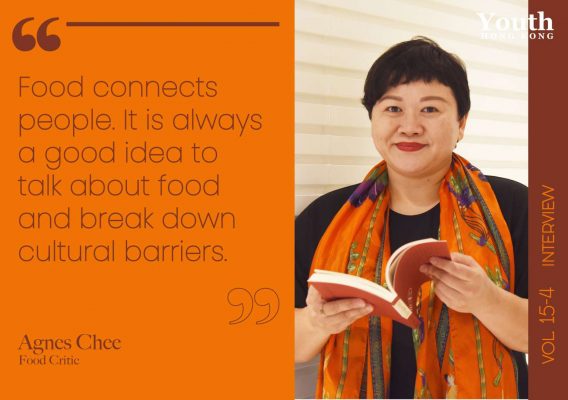//vol.15-4 Interview: Agnes Chee
Preserving Our Food Memories
Before the book The Vanishing Flavours of Cantonese Cuisine came into existence, Agnes Chee, a food critic based in Hong Kong, had observed the gradual disappearance of traditional Cantonese dishes.
In this issue, we sat down with Agnes and talked about food, Hong Kong, and culture preservation. In an increasingly globalised and homogenised world where people seek efficiency, novelty, and eccentricity, preserving extinguishing food cultures, as well as how to address the clash between the old and the new, remains a challenging task.
Documenting Vanishing Flavours
There were dishes that even Agnes had never heard of: double-boiled pig’s stomach stuffed with chicken and bird’s nest, lamb cheek and knuckle soup, Jinhua ham and “snowflake” chicken slices. At least not until she met “Brother Seven,” Chui Wai-kwan.
One after another, the Malaysian writer heard stories about how to source rarely-found ingredients, popular dishes from decades ago, and how things and people have changed. Unfortunately, the recipes of these delicate regional cuisines, originating from the Guangdong region, are gradually disappearing and becoming a mystery. This is largely due to their high cost, difficulties in sourcing ingredients, and the labour-intensive nature of preparation.
Agnes then came up with the idea of documenting these vanishing Cantonese cuisines. The resultant book, The Vanishing Flavours of Cantonese Cuisine took her five years to complete and was made the more challenging given that some Chinese chefs were reluctant to share their recipes with outsiders, preferring to reserve this knowledge for family members only.

Curiosity: a Key “Ingredient”
Agnes started writing about food 12 years ago when she was assigned a task to interview a three-star Michelin chef. However, the interview turned out to be an awkward experience, as she reflects, “I looked stupid. I felt sorry for him as well, because I couldn’t understand all the terms about French cooking.” This prompted her to better her knowledge and she began buying books and studying about French cuisine. “After that, every time when I interviewed a chef, I did a lot of research online and studied their interviews in the past three or five years so that I could really understand their passion.”
All the research and professional input helped Agnes establish her reputation in the industry. As her journey evolved, Agnes transitioned from being starstruck by famous chefs and luxurious dining experiences to developing a deeper passion for acquiring and sharing knowledge about food and cooking methods. The continuous discovery of new knowledge in the culinary world becomes the most exciting and rewarding aspect of writing about food.
“Food connects people. It is always a good idea to talk about food and break down cultural barriers.”
Hong Kong vs. Cantonese Food
As her knowledge deepened about food in general, Agnes turned back to her own roots, marrying it with the food of her adopted city. What she saw was how Hong Kong food was really a fusion of British colonial and local Cantonese culture. With dishes like Hong Kong style baked pork chop rice and tomato sauce or macaroni for breakfast or the unique blend of milk tea mixed with coffee, or Yuanyang, Hong Kong was making a very distinct mark of its own.
As she explains, there is a clear separation from Cantonese Food, which is the traditional cuisine from the broader Guangdong region, especially Shunde, a well-known district known for its culinary dishes. Cantonese cuisine emphasises freshness and original flavours, using seasonal ingredients and includes dishes like steamed fish and seafood with various fermented ingredients, aiming to bring out the natural tastes of high-quality raw ingredients.

Colourful Hub
While Hong Kong has its own inimitable dishes, the city itself is becoming well known for its food scene, with its international and diverse culinary offerings. It goes beyond just mainstream international cuisines like Indian, Thai, Vietnamese Korean and Japanese, one can enjoy niche options from places as far flung as South America, Iran, Ukraine, Ethiopia and Scandinavia. In addition to international cuisines, Hong Kong boasts a wide range of Chinese regional cuisines from regions like Ningbo, Shanghai, and Fujian.
In Agnes’ view, this openness to international tastes, as well as Hong Kong’s geographical location and centre as a global trading hub, has made the city a stepping stone for businesses entering the Chinese market. Foreign companies and restaurants often establish themselves in Hong Kong before trying to expand into mainland China.
Conserving Culture
In the end, as regional dishes get more and more diluted in the context of globalisation, Agnes encourages young people to stay curious and explore the origins of what they are eating to gain a deeper understanding about food.
And as foods begin to disappear, Agnes firmly believes that it is important to try one’s best to preserve food cultures as intangible cultural heritage. While not everyone will be a food writer, most people already share their food on their social media feeds. She recommends documenting these experiences and sharing photos and videos, but with stories and comprehensive knowledge behind each dish, instead of only sharing good-looking pictures.
Preservation will only happen, Agnes says, if one has curiosity to delve deeper into what it is that they are sharing. Similarly, she encourages young people to share their family culinary traditions as a way to preserve food culture. This way, one can be sure that knowledge and tradition will be passed down to future generations. ■
How to order Cha Chaan Teng dishes in Cantonese?
Milk Tea (奶茶): naai5 caa4
Hong Kong Style Tea and Coffee (鴛鴦) : jyun1 joeng1
Noodles with Luncheon Meat (餐蛋麵): caan1 dan2 min6
French Toast (西多士): sai2 do1 si6
Pineapple Bun (菠蘿包): bo1 lo4 baau1
Baked Pork Chop Rice (焗豬排飯): guk6 zyu1 paai4 faan6
Beef Noodles (乾炒牛河): gon1 caau2 ngau4 ho4
Red bean ice (紅豆冰): hung4 dau6 bing1


